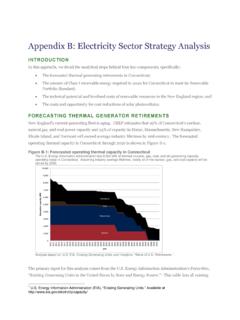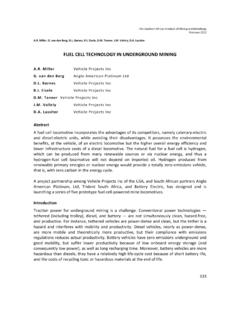Transcription of Proton Exchange Membrane Fuel Cells
1 UNESCO EOLSSSAMPLE CHAPTERSENERGY CARRIERS AND CONVERSION SYSTEMS Vol. II - Proton Exchange Membrane fuel Cells - Akira Watanabe Encyclopedia of Life Support Systems(EOLSS) Proton Exchange Membrane fuel Cells Akira Watanabe Tokyo Electric Power Company, Japan Keywords: solid polymer electrolyte, Ion Exchange Membrane , Mea( Membrane /electrolyte assembly), low temperature operation, management of the water content, humidication methods, catalyst poisoning, reforming of hydrocarbon fuels, CO removal reactor, fuel cell electric vehicles. Contents 1. Introduction 2. Principle of Operation 3. Construction 4. Features 5. System Configuration 6. fuel Cell Electric Vehicles 7. Direct Methanol fuel Cells Glossary Bibliography Biographical Sketch Summary Proton Exchange Membrane fuel Cells employ a polymer ion Exchange Membrane as the electrolyte. Due to recent advancement in the technology, both stationary and automobile applications are thought to give rise to a significant impact on the conventional energy system.
2 This article describes the background and perspective as well as the principle and features of the technology. Also, direct methanol fuel Cells are briefly covered. 1. Introduction Proton Exchange Membrane fuel Cells (or PEMFCs) employ polymer ion Exchange membranes as the electrolyte; among their features are a low operating temperature, and the potential for high output-density operation owing to the fact that the contact area between electrode catalyst and ion- Exchange Membrane can be made large. Initially, such fuel Cells were developed by General Electric of the US, with a view to incorporating them in spacecraft. Thereafter, with further improvements, performance was dramatically improved in the 1970s, most significantly because of the appearance of a heat-resistant ion- Exchange Membrane by Du Pont, called Nafion. The subsequent development has resulted, in the late 1980s, in the fuel cell stack with new membranes manufactured by Ballard, a canadian fuel cell developer and manufacturer.
3 The improved characteristics encouraged the development of PEMFCs. There has also been research performed on methods for reducing the quantity of platinum catalyst, which had been necessary in quite large quantities. Expectations are being placed on advances in these areas. UNESCO EOLSSSAMPLE CHAPTERSENERGY CARRIERS AND CONVERSION SYSTEMS Vol. II - Proton Exchange Membrane fuel Cells - Akira Watanabe Encyclopedia of Life Support Systems(EOLSS) Among them, Daimler-Chrysler has announced their future strategy for the fuel cell vehicle, based on the technology by Ballard. Also, Toyota Automobile has developed fuel cell driven cars in order to demonstrate the possibility and hurdles for its realization. Although, there is no doubt that the introduction of fuel cell vehicles helps in increasing the thermal efficiency in transport sectors and reducing the pollution problems in urban cities, there are many problems such as cost, performance and infrastructure for fueling.
4 Apart from the vehicle applications, small scale PEMFCs, for residential use, are being developed by several manufactures, with a view to introducing a new concept of personal power generation. Due to its features of low temperature operation and improved Membrane performance, it has become foreseeable that PEMFCs can be used as a practical power source for automobiles. Since the automobile market will enable considerable mass production of fuel Cells , there is high expectation of reduced cost in future. Also, its environmental adaptability (or friendliness to the environment) encouraged major car manufacturers to develop fuel cell driven automobiles. 2. Principle of Operation The explanation of the operation principle for PEMFCs is similar to that for PAFCs. Electrode reactions take place upon supplying hydrogen to the fuel electrode and oxygen to the air electrode, and thus an electric current can be obtained (see Figure 1).
5 At the fuel electrode, the hydrogen is converted into hydrogen ions and electrons. -+- fuel electrode: H22H + 2e The hydrogen ions pass through the ion- Exchange Membrane to reach the opposing air electrode. At the air electrode, the hydrogen ions combine with the electrons, which have passed through the external load circuit and with oxygen supplied to the air electrode in a reaction, which produces water. +22 Air electrode: 1/2O + 2H + 2eH O Apart from the electrode reactions, a key issue is that for this type Proton Exchange Membrane , ion conductivity will appear only when the Membrane appropriately contains water moisture. It is therefore important to regulate the water content in the Membrane by humidifying the reactant gases being supplied. Also, because the ion conductivity depends on the Membrane thickness, it should be as thin as the constraints on strength and durability will allow. The operating temperature is limited by the heat resistance of the ion- Exchange Membrane , though a high temperature is desirable to improve cell characteristics.
6 At present operating temperatures are around 100 C. UNESCO EOLSSSAMPLE CHAPTERSENERGY CARRIERS AND CONVERSION SYSTEMS Vol. II - Proton Exchange Membrane fuel Cells - Akira Watanabe Encyclopedia of Life Support Systems(EOLSS) Figure 1. Principle of Operation of Ion- Exchange Membrane fuel Cells - - - TO ACCESS ALL THE 8 PAGES OF THIS CHAPTER, Visit: Bibliography Chalk S. G., Milliken J. M., Miller J. F. and Venkateswaran S. R. (1998). The US Department of energy -investing in clean transport. Journal of Power Source 71, 26 35. [The development by the US Department of energy is recommended.] Cleghorn S. J. C., Ren X., Springer T. E., Wilson M. S., Zawodzinski C., Zawodzinski T. A. and Gottersfeld S. (1997). Pem fuel cell for transportion and stationary power generation applications. International Journal of Hydrogen energy 22(12), 1137 1144. [The low cost cell fabrication methanol reforming and DMFCs are recommended.]
7 ] UNESCO EOLSSSAMPLE CHAPTERSENERGY CARRIERS AND CONVERSION SYSTEMS Vol. II - Proton Exchange Membrane fuel Cells - Akira Watanabe Encyclopedia of Life Support Systems(EOLSS) Divisek J., Oetjen , Peinecke V., Schmidt V. M. and Stimming U. (1998). Components for PEM fuel cell systems using hydrogen and CO containing fuels. Electrochemica Acta 43(24), 3811 3815. [The influence of cell performance by CO in fuel and some methods to avoid CO poisoning are recommended.] Gierke T. D., Munn G. E. and Wilson F. C. (1981). The morphology in Nafion perfluorinated Membrane products, as determined wide- and small-angle. Journal of Polymer Science 19, 1687 1704. [The structure of ion Exchange Membrane is recommended.] Naylor P. D., Barton R. T., Mitchell P. J., Lakeman J. B. and Jordan K. E. (1991). Performance determining characteristics of solid polymer fuel cell electrodes. Power Sources (GBR) 13, 253 261. [The overview of PEMFCs and the performance of some fabricated Cells are recommended.
8 ] Prater K. (1990). The renaissance of the solid polymer fuel cell. Journal of Power Source 29, 239 250. [The performance of the cell used Dow Membrane is recommended.] Srinivasan S., Ticianelli E. A., Derouin C. R. and Redondo A. (1988). Advanced in solid polymer Electrolyte fuel cell technology with low platinum loading electrodes. Journal of Power Source 22, 359 375. [The improvement of cell performance is recommended.] Staiti P., Poltarzewski Z., Alderucci V., Maggio G., Fasulo A. and Giodano N. (1991). Influence of Hydrophobic hydrophilic properties of porous gas diffusion later on the water management in a SPEFC. Intersociety energy Conversion Engineering Conference (US), 26(3), 619 623. [The influence of cell performance by water content is recommended.] Biographical Sketch Akira Watanabe was born 22 August 1967, in Japan and has received a bachelor s degree from the College of Engineering Sciences, University of Tsukuba.
9 He works with the Tokyo Electric Power Company.


















